E.G. Lewis's Blog, page 4
June 4, 2012
FOODS of the FIRST CENTURY - SWEETS & SWEETNERS
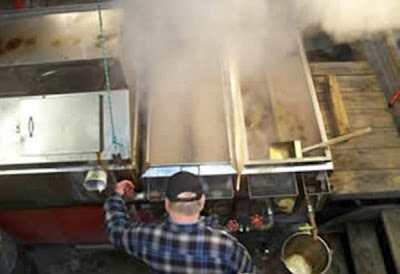 Making Vermont Maple Syrup with the Traditional Evaporator
Making Vermont Maple Syrup with the Traditional EvaporatorHello My friend and Welcome.
In our continuing study of Foods of the First Century we turn to an interesting aspect of the Early Christians diet: Sweets. In the sugar saturated society that we live in it’s hard to imagine a world without Twinkies, Soda Pop, Candy, Sugar-Coated Cereals…the list goes on and on. Sweets of one kind or another seem to be everywhere. A quick check of the ingredient lists on some of the items in our cupboard demonstrates how ubiquitous sugar, in its many permutations, has become.
A BUILT-IN SWEET TOOTHLike it or not, we humans seem to come with a built-in sweet tooth. And we currently quench it with mountains of refined sugar, and millions of gallons of high fructose corn syrup. But what about our Christian cousins of the First Century? They somehow survived without a convenience store on every corner. How did they do it?
We know a couple of things about sugars. First, they seem to be somewhat addictive; the more you get the more you want. And secondly, a high intake of sugars in the diet tends to dull the taste buds. An apple or a pear can never match the intense sweetness of a bowlful of sugar-coated crunchy-munchies. So, while making do with less sugar than modern man, perhaps our ancestors were able to enjoy the natural sweetness of fruits and berries far more than we do today.
LIVING IN SUGARLESS WORLDStill, there’s that sweet-tooth thing that makes us all crave sweetness. Rest easy, perhaps life was a little sweeter than we imagine. First, and foremost, they had honey. Evidence of large apiaries producing tons of honey annually have been found in the Holy Land. You can read our post on that HERE. People of that era also produced a number of syrups, molasses-type products, which they incorporated into their cooking in many ways.
How effective could fruit syrups be, you ask? The next time you’re in the grocery store stop by the bakery department and check the ingredients on one of their “Sugar-Free” pies. What you will find is that these pies, instead of being sweetened with refined sugar made from sugar cane or sugar beets (sucrose), are sweetened with fruit sugar (fructose).
THINK MAPLE SYRUPMost people have at least a peripheral understanding of the process for making maple syrup. Sap from a sugar maple tree is collected in early spring and transported to the sugaring house. There it is filtered and poured into a shallow evaporator with dividers that allow the operator to move the syrup from one section to the next as it slowly thickens. What comes in on one end as raw sap with barely any detectable sweetness emerges on the opposite end as that golden brown ambrosia we all know and love.
In reality, the sugar content of any semi-sweet juice can be increased by boiling to liquid to syrup. The following is a list of the most common syrups produced in the First Century. These syrups, or molasses, are still widely used in the Middle East.
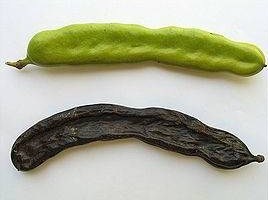 Carob Pods - Green and Mature
Carob Pods - Green and MatureCAROB MOLASSESWe mentioned Carob in our post on vegetables and made passing reference to the pods being used as a sweetener. Today, we’ll examine that in greater detail. The syrup is produced by shelling the beans and finely chopping the empty pods into water. This mixture is then cooked to extract the sugars from the pods, It is strained and reduced into a thick syrup, or carob molasses as it is called. Carob molasses is 100% carob extract with a rich aroma, flavor and color. It has a high natural sugar content, and can be used alone as syrup, or as sweetener, colorant, and flavoring agent in ice-cream toppings, cakes, cookies, and sweetmeats.
In Lebanon, the site of the ancient kingdom of Phoenicia, carob molasses is traditionally used as an alternative to sugar. Mixed and served with tahina, or sesame paste, it is eaten as a dessert called dibs bi tahina. Carob molasses is also said to be delicious on pancakes.
Interestingly, carob seeds have a history of their own. The carob seed looks very much like a large watermelon seed. There are about eight seeds to a pod. The gum they contain was used by the Egyptians for binding their mummies. The Italians use the seed to make rosary beads and in Israel they have an annual Carob Festival.
Because carob seeds are very uniform in weight, they were used as a measure for gold and gems. This carob weight has come down through the centuries as the familiar caret weight. One half of a carob seed equals one gram, or five carets.
 Bowl of Date Syprup in the Making
Bowl of Date Syprup in the MakingDATE SYRUPThe juice of most fruits is obtained by pressing. Dates are different because their soluble solids are too concentrated to be pressed out. A minor exception to this rule is the incidental by-product when bagged dates are heaped on top of each other in a humid warehouse. Over a period of time small amounts of syrup will ooze out due to the force of the downward pressure. Clearly this is no way to produce usable syrup. To make date syrup at home, buy the softest dates you can find. Chop or crush them and put them in a narrow pan. Cover with water and bring to a boil. Let it boil for 5 minutes, then put it on the lowest heat and simmer for 30-60 minutes. Very soft dates do not require as much cooking. Remove from heat and let cool. Once the mixture is cool, put it into a blender and run on liquefy. If small pieces remain, pour the syrup through a sieve to remove them. The resulting dark syrup can be used as a replacement for maple syrup or honey when cooking and can also substitute for sugar when baking cookies.

FIG SYRUP This syrup is made by scoring dried figs, placing them in large pots of water and letting them reconstitute for 12 hours. When the figs have softened, they are boiled and the juice produced is strained off. This juice is then boiled down to thick syrup. Fig syrup is used in cakes, fritters and many desserts. It also replaces maple syrup over French toast, waffles and pancakes.
 GRAPE SYRUP Also known as debash, it is mentioned several times in my Seeds of Christianity™ Series of books. In Greek it is πετιμέζι, pronounced peh-tee-MEH-zee. Grape syrup is naturally sweet and eaten with yogurt, over ice cream, in tea, on pancakes, in baking. In mountainous regions, it is also used to make an impromptu snow cone by pouring it over fresh snow. A teaspoonful will work wonders for sore throats due to colds.
GRAPE SYRUP Also known as debash, it is mentioned several times in my Seeds of Christianity™ Series of books. In Greek it is πετιμέζι, pronounced peh-tee-MEH-zee. Grape syrup is naturally sweet and eaten with yogurt, over ice cream, in tea, on pancakes, in baking. In mountainous regions, it is also used to make an impromptu snow cone by pouring it over fresh snow. A teaspoonful will work wonders for sore throats due to colds. The syrup is made by crushing the grapes and adding a small amount of wood ash to the must, as crushed grapes, juice and skins are called. The mixture is boiled in small batches and then strained. The resulting thickened juice is boiled and reduced to a thick reddish syrup.
There is apparently no end to the uses for these ancient syrups and sweeteners. One firm markets product to add to your bath water. It contains syrups from wild figs and grapes along with emollient oils and is said to freshen and soften the skin. We have no information regarding the use of such a product by the Early Christians, however, it seems unlikely to say the least.

POMEGRANATE SYRUP All of the modern recipes for pomegranate syrup shorten the process by combining the juice with refined sugar in a ratio of 1 part sugar to 4 parts juice before it is reduced. True, pomegranates do have a tart, tangy taste and may require some sweetening, but clearly this is not the way it was done 2,000 years ago. They would have prepared the syrup by first boiling down the pomegranate juice and then sweetened it as needed by adding small amounts of honey. Unlike the other syrups and molasses we’ve been looking at, pomegranate syrup wasn’t used as a topping or sweetener. Instead, it served as a marinade that was brushed onto various meats before grilling. It is still used that way today.
Until next time, Shalom Aleichem!
If you reached this post via a link, click the HOME tab above to see other recent posts and visit our archives.
Published on June 04, 2012 01:00
May 29, 2012
THE PYRAMIDS OF NUBIA
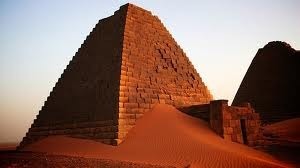
Hello My Friend and Welcome.
Technically, a pyramid is geometric solid with a square base and four isosceles (equal–sided) triangles forming its sides. But to most people a pyramid is any structure that is more or less shaped like a triangle.
Say the word pyramid, and people immediately think Egypt. But they do exist in other places. An example is the Transamerica Building in downtown San Francisco. Even though it is technically not a pyramid, everyone calls it the Transamerica Pyramid. By this definition, the Assyrian Ziggurats are a type of pyramid as well as the Mayan temples of Central America. The last Egyptian pyramid was built in Abydos by the first king of the Eighteenth Dynasty, Ahmose I, who ruled from 1549-1524 BC. Remember that date; it’s going to become important.
NOT THE ONLY PYRAMIDSInterestingly enough, there are other pyramids — real pyramids, not just pointy structures — on the African continent. As a matter of fact, the ancient kingdom Nubia (now known as The Sudan) had twice as many pyramids as Egypt. And you’ve probably never even heard of them until now.
It was the Greek philosopher Strabo who, after meeting members of the Nabo tribe in the First Century, dubbed their land Nubia. A thousand years before Strabo was born, the Egyptians had called it Ta-Seti, or the Land of the Bow. In the Old Testament it is known as Kush and the only pyramid builder the Bible mentions is King Taharqa, who ruled from 690 – 664 BC. Let’s revisit those dates. Why did the Nubians…Ta-Setis…Kushites…whatever, begin building pyramids eight centuries after the Egyptians abandoned the practice?
The answer lies in the historic relationship between the two regions. For over a thousand years the Egyptians dominated Nubia. The frescoes showing the Nubians bringing tribute to the Pharaohs depict them as darker and with curly hair. This was clearly intended to show that the Egyptians were different from, and therefore superior to, the Nubians.
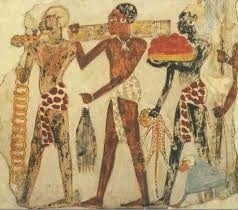 Frescoe of Nubians Bringing Tribute
Frescoe of Nubians Bringing TributeBut over time Egypt declined and Nubia eventually broke free. However, after thousands of years of commerce and interchange, the Nubians worshipped the same gods and shared the same culture. In 722 BC, when Egypt was at its weakest, the Nubian King, Piye, marched north and conquered his ancestor’s former masters. Rather than seeing themselves as outsiders, he and his successors called themselves Pharaohs and established Egypt’s 25th Dynasty.
ELABORATE TOMBSTONESYet when Piye died, he was returned to Nubia for burial and above his grave there was…you guessed it…a pyramid! Clearly these rulers saw themselves as cut from the same cloth as Egypt’s great rulers. Rulers who, as a testimony to their power, had been buried within pyramids.
This is where we encounter another Nubian quirk. Their pyramids were not tombs. This confused grave robbers and archaeologists alike until it was discovered that the Nubians cut their burial chambers in to the bedrock. The stairway leading to the burial chamber would be filled in after burial and the pyramid constructed on top. In order to accomplish this, the deceased successors would have to have constructed the pyramid. In effect the pyramids were nothing more than an elaborate tombstone.
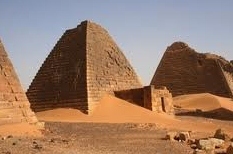
This practice continued for 300 years. Eventually the Assyrians drove the Nubian ruler out of Egypt and the Nubians were forced into a long retreat into the southern reaches of their homeland. They began building pyramids in an isolated area called Meroe around 270 BC and, out of contact with Egypt and the rest of the world, continued for hundreds of years.
Christianity eventually reached the kingdom of Meroe and sometime around 350 AD a king of Meroe built the last pyramid ever constructed on the African continent.
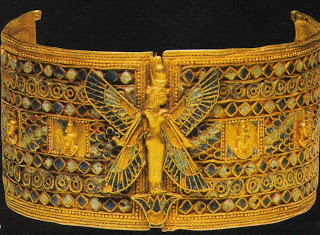 Queen Amanishaketo"s Gold & Jeweled Bracelet
Queen Amanishaketo"s Gold & Jeweled Bracelet GOING TOPLESS IN THE DESERT
You can thank treasure hunter Guiseppe Ferlini for the deteriorated condition of the Nubian pyramids. He obtained permission to explore and excavate in 1934 from the governor of Khartoum. After fighting off lions, he arrived at Meroe and struck gold, the jewels of Queen Amanishaketo who ruled around the time of the birth of Christ. Rather than admit that he had discovered her underground burial chamber, he said he found the jewelry in a chamber at the top of the pyramid. When word spread, other treasure-hunters flocked to the area and began tearing open the tops of the pyramids searching for treasure that wasn’t there. The end result was lots of damaged pyramids.
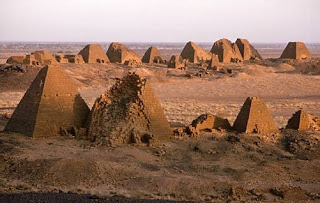
On Friday, we’ll be examining the ancient game known as Tabula.
Until then, we wish you Peace and Blessings.
If you reached this post via a link, click the HOME tab above to see other recent posts and visit our archives.
Published on May 29, 2012 01:00
May 25, 2012
REVIVING ANCIENT TRADITIONS of ISRAEL
 Blowing the Shofar (Ram's Horn) Begins the Ceremony
Blowing the Shofar (Ram's Horn) Begins the CeremonyHello My Friend and Welcome. Renewing a tradition of ancient Israel, hundreds of women gathered again to celebrate the Tu B'Av (the 15th of Jewish month of Av) holiday on the biblical site of Shiloh in the region allotted to the tribe of Benjamin. For centuries the young women of Shiloh would go out to the vineyards and orchards and dance on the joyous holiday of Tu B'Av. This month a group of Israeli women returned to the orchards in a multifaceted celebration of dance organized by the Benjamin Regional Council.
LINKS TO THE EARLIEST OF TIMESThis tradition of dancing in the vineyards and orchards began very early in Jewish history. It is recounted in Judges 21:16-23. We are told that, since the Benjamites had no wives, the other tribes sent maidens to Shiloh to dance in the vineyards. While they danced, the Benjamite men hid amid the surrounding vegetation. When each of them saw a young woman they wanted, they caught her, and married her. Hence the Benjamites secured wives and the other tribes were absolved of any responsibility.
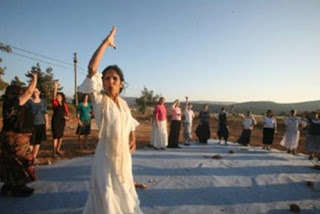
Shiloh played an interesting role in ancient Israel. During the period of the Judges the sanctuary of God, designated a temple, was first built in Shiloh (Judges 18:31). Samuel’s parents also went to Shiloh and his mother, Hannah, prayed to the Lord and offered to consecrate the child he would give her. (1 Samuel 1:9-24). And the Ark of the Covenant was stored in the temple at Shiloh prior to it being captured by the Philistines. (1 Samuel 4:3-17).
The women at Shiloh participated in various dance workshops including modern dance, belly dancing, flamenco, and finally a central dance in the main square overlooking the site of the ancient Mishkan(Tabernacle) of Shiloh.
BENEFITS FOR THE PARTICIPANTSOne participant in the festival described the experience to Israel National News. “The workshops were amazing,” she said. “I learned how to dance Flamenco style from a true expert. The Noga dance troupe, comprised of religious women, put on a talented and surprisingly modern performance. Afterwards, it was really uplifting to dance together with my good friends. It was so much fun.” Festival organizer, Tamar Asraf said, “For a moment, hundreds of women were able to stop the race of life, to connect to themselves, to remove the partitions, and to renew the holiday of Tu B'Av where it all began – here in Shiloh.”
Until next time, we wish you Peace and Blessings
If you reached this post via a link, click the HOME tab above to see other recent posts and visit our archives.
Published on May 25, 2012 07:11
May 24, 2012
FREE PROMOTION - LOST by E G LEWIS
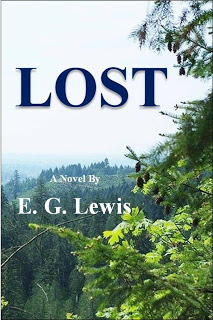
A final reminder for Sowing the Seeds readers regarding the Free Promotion of my novel, LOST. Today is the last day to get the Kindle edition free on Amazon. If you are an eReader, don't delay! Follow THIS LINK to download your free copy and be sure to tell your friends. I’ve included a synopsis and excerpts of several reviews below.
Three Good Ideas Converge to Form One Great CatastropheLOST is first and foremost a story about love, a special love that binds two hearts together transcending time and space. Told through parallel storylines, their point of convergence is the disappearance of the cruise ship, Paradise Voyager, while in Alaskan waters. The common thread linking them together is the impact they had upon the life of Oregon newspaperman, Thomas Jenkins, whose wife and granddaughter were aboard the ship.When officials declare the Voyager irretrievably lost, Tom rejects their conclusion and strikes out on his own. Assembling the unlikely team of two Vietnam Vets, an Indian scientist and a supermodel, he goes on the offensive and eventually unravels the mystery. When the final piece of the puzzle turns out to lie not in the Gulf of Alaska, but in the Oregon woods Tom sets off into the forest alone determined to save his wife and granddaughter...or die trying.
What the reviewers say..."Lost is a character-driven mystery with touches of high-finance, science fiction, love and ethics adding to its depth. Set solidly in the years leading up to the millennium, in beautifully described countryside with forest, pine and ocean, rain and sun, with a plot uniting elements from Indian mythology to the local Chinese restaurant, it's a wonderfully evocative telling of high-jinks on the high seas tempered with human care and concern."
"The author shows enviable skill in building believable science without weighing down the story. The humorous timing is as enjoyable as the well-drawn action and adventure. A great adventure, some intriguingly imaginative concepts, wonderful characters, and a beautiful sense of Southern Oregon scenery and community (with touches of India, London, and more besides), this is a very enjoyable novel which really does satisfy."
"Military secrets, corruption, greed, international intrigue; tenderness, human frailty, devotion, and loyalty. All of these describe Lost by E.G. Lewis. ...breathtaking descriptions of the Oregon scenery, with touching glimpses into the emotional make up of the characters flow seamlessly into scenes of high intensity action. It’s a mystery, romance, action, thriller rolled into one. I highly recommend this book to readers looking for a great mystery."
"A storyline you don't expect; a tale you won't forget. In Lost, Mr. Lewis treats us to glimpses of the past, present, and a possible future, and ties them together in an intriguing tale that juxtaposes deception with integrity, and grief with hope. Mr. Lewis has produced a unique story that pits the staying power of love and devotion against the forces of fate as manipulated by the intervention of greedy men. Well researched and thoughtfully written, this is a story you'll ponder well beyond the final page."
Get your free copy of LOST for the Kindle today!
Published on May 24, 2012 01:00
May 22, 2012
FREE PROMOTION - LOST by E G LEWIS

Just a reminder to Sowing the Seeds readers. The Free Promotion of my novel, LOST is still going on. The Kindle edition will be free on Amazon through Thursday, May 24th. If you are an eReader, I urge you to follow THIS LINK to download your free copy. Be sure to tell your friends. I’ve included a synopsis and excerpts of several reviews below.
Three Good Ideas Converge to Form One Great CatastropheLOST is first and foremost a story about love, a special love that binds two hearts together transcending time and space. Told through parallel storylines, their point of convergence is the disappearance of the cruise ship, Paradise Voyager, while in Alaskan waters. The common thread linking them together is the impact they had upon the life of Oregon newspaperman, Thomas Jenkins, whose wife and granddaughter were aboard the ship.When officials declare the Voyager irretrievably lost, Tom rejects their conclusion and strikes out on his own. Assembling the unlikely team of two Vietnam Vets, an Indian scientist and a supermodel, he goes on the offensive and eventually unravels the mystery. When the final piece of the puzzle turns out to lie not in the Gulf of Alaska, but in the Oregon woods Tom sets off into the forest alone determined to save his wife and granddaughter...or die trying.
What the reviewers say..."Lost is a character-driven mystery with touches of high-finance, science fiction, love and ethics adding to its depth. Set solidly in the years leading up to the millennium, in beautifully described countryside with forest, pine and ocean, rain and sun, with a plot uniting elements from Indian mythology to the local Chinese restaurant, it's a wonderfully evocative telling of high-jinks on the high seas tempered with human care and concern."
"The author shows enviable skill in building believable science without weighing down the story. The humorous timing is as enjoyable as the well-drawn action and adventure. A great adventure, some intriguingly imaginative concepts, wonderful characters, and a beautiful sense of Southern Oregon scenery and community (with touches of India, London, and more besides), this is a very enjoyable novel which really does satisfy."
"Military secrets, corruption, greed, international intrigue; tenderness, human frailty, devotion, and loyalty. All of these describe Lost by E.G. Lewis. ...breathtaking descriptions of the Oregon scenery, with touching glimpses into the emotional make up of the characters flow seamlessly into scenes of high intensity action. It’s a mystery, romance, action, thriller rolled into one. I highly recommend this book to readers looking for a great mystery."
"A storyline you don't expect; a tale you won't forget. In Lost, Mr. Lewis treats us to glimpses of the past, present, and a possible future, and ties them together in an intriguing tale that juxtaposes deception with integrity, and grief with hope. Mr. Lewis has produced a unique story that pits the staying power of love and devotion against the forces of fate as manipulated by the intervention of greedy men. Well researched and thoughtfully written, this is a story you'll ponder well beyond the final page."
Get your free copy of LOST for the Kindle today!
Published on May 22, 2012 01:00
May 21, 2012
FOODS OF THE FIRST CENTURY— MEAT, MILK & CHEESE
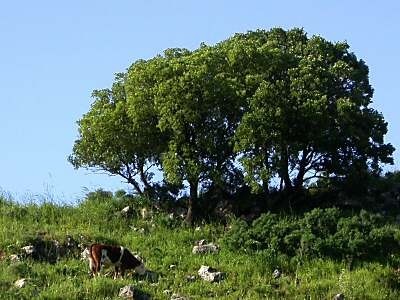 Cattle on the Golan Heights - Ancient Bashan
Cattle on the Golan Heights - Ancient BashanHello My Friend and Welcome.
Today we continue our series on Foods of the First Century with Meat, Milk and Cheese. If you’ve missed any of the posts and would like to catch up on them, they are all available in the lower left sidebar under Archives By Topic. And now, on to Meat, Milk, and Cheese. As always, we’ll start with a Biblical list and move on from there. Calf (Proverbs 15:17; Luke 15:23) The proverbial Fatted Calf was a treat reserved for the very rich, or a communal celebration. Clearly the only way the average person could consume this very best beef would have been at a village wedding feast where there would be enough people to eat the 400-500 pounds of meat a finished steer yields. The very term calf immediately tells us it is a young animal, therefore tender, and fatted means it had been fed specifically for meat consumption. This is the rough equivalent of a feedlot steer or heifer in the United States. Today a calf spends its first six or seven months with its mother nursing and growing. It is weaned at between 450 and 500 pounds. When it reaches 650 pounds it is moved into a feedlot where it’s fed a high energy ration designed to produce the marbling that gives the meat juiciness and flavor. Three to four months after entering the feedlot, the animal weighs slightly over 1,000 pounds and is sent to the slaughter house at slightly over one year of age.We have already seen that ancient Israel had well-developed commercial aviaries and apiaries. Clearly, they also had large areas given over to the raising of cattle. The livestock of Bashan in the northern part of Israel, the modern-day Golan Heights, was known for being fat and healthy. Psalm 22:12 mentions the strong bulls of Bashan; Ezekiel 39:18 mentions the fatlings of Bashan. And how can we forget Amos 4:1where he wrote, “Hear this word, you cows of Bashan, who are on the mountain of Samaria…” While it’s true that the skinny ideal of feminine beauty is a modern phenomenon and in ancient times plumpness was seen as a sign of affluence, we can be fairly certain that at no time in human history has a woman appreciated being called a fat cow.
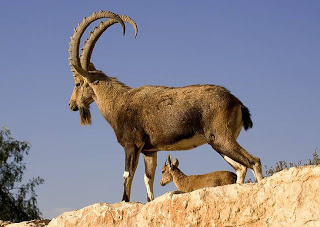
Goat (Genesis 27:9) Goat meat was the food of the common man. It is still widely consumed in the Middle East. The Bible also mentions the Ibex, or wild goat, which was hunted. (1 Samuel 24:2) The Ibex was also the most probable source of the shofar, or ram’s horn trumpet.Cow's milk was known, but not used very much. Sheep and goats were the preferred source of milk, which was used to make butter or cheese. The milk could be clabbered, that is, turned in leban...a sort of yougurt that was eaten plain, or flavored with fruit or thickened fruit juice. Leban is one of the oldest and best-loved foods of the Bible lands. When making cheese from the raw milk, they first separated the butterfat. This was done by pouring the raw milk into a bag made from a goat’s stomach. It had a strap attached that, when worn over the shoulder, agitated the bag as one went about their daily chores. After separation, the buttermilk was strained off and cultured with leban from a previous batch to start the coagulation…similar to adding a starter to dough to leaven bread. After the leban thickened the buttermilk, it was put into cloth sacks and the water squeezed out of it. The cheese-like result, when rolled into balls and dried, would keep indefinitely.
Lamb and Sheep (2 Samuel 12:4) There are a multitude of references to both lamb and sheep in both the Old and New Testament. The most familiar is the preparation of the Paschal Lamb for the Passover meal. There is also strong evidence of a concentrated area of shepherds near Bethlehem who raised lambs for the Temple.
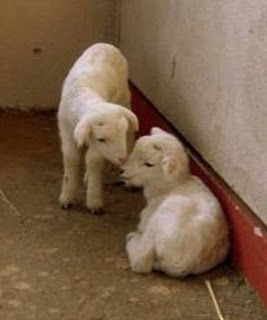
Oxen (1 Kings 19:21) The ox may have been mankind's earliest draft animal. Written sources, paintings, and sculptures indicate their usage dates back a minimum of five thousand years. They are found in art and records from Egypt, Ur, and Babylon. Every farming civilization that had access to some breed of bovine has used them for draft purposes. An ox is defined as a neutered male bovine trained for and used as a draft animal. The neutering of a male calf alters its growth patterns and personality giving it a more docile temperament. The meat from an ox is very different from that of the fatted calf. The ox would have subsisted on coarse roughage. That, along with its work regime and advanced age at slaughter, would have precluded the juicy tenderness associated with the fatted calf. Oxen are typically used in pairs known as a team. When working, the two animals were joined by a wooden yoke. The most common form is the neck or bow yoke which consists of a shaped crosspiece (the yoke) that rests on the top of the ox's neck, just in front of his shoulder blades, and a U-shaped piece (the bow) that goes under the neck with its ends going up through two holes in the yoke. The yoke must be carefully carved, fitted and smoothed so that it does not irritate the animal’s neck when it works.
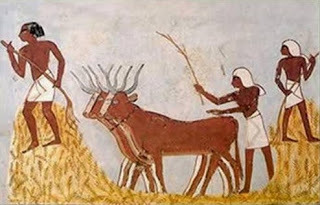 Egyptian Wall Painting of Oxen Threshing Grain
Egyptian Wall Painting of Oxen Threshing GrainOne could do an entire study on the use of the word yoke in the Bible. In the Old Testament it is used figuratively to reflect severe bondage, or affliction, or subjection (Lev. 26:13; 1Kings 12:4; Isa 47:6; Lam 1:14, 3:27). In the New Testament the word yoke denotes servitude (Matt 11:29-30; Acts 15:10; Gal 5:1). There is also Paul’s warning in 2 Corinthians to not be yoked with an unbeliever. And Jesus’ famous saying in Matthew 11:30, “For my yoke is easy and my burden light.”
Venison (Genesis 27:7) Venison is also mentioned in the Bible. The word derives from the Latin vēnor, to hunt or pursue. I would suggest that vension is a generic reference to all the wild animals in the deer family that were hunted such as roe deer, fallow deer, Arabian oryx, antelopes, etc.
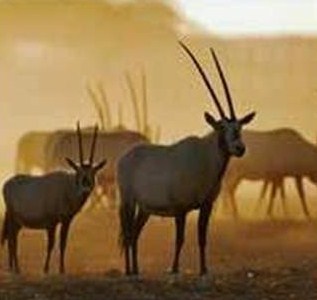 Arabian Oryx
Arabian OryxThere is another “meat” source mentioned in the Bible. Both Mark and Matthew mention John the Baptist subsisting on locusts and wild honey. Yuck! If, like me, you grew up in the eastern half of the United States, when you heard this passage you most likely thought of cicadas. In actuality, what the Bible is referring to is an insect in the grasshopper family.
So how did cicadas, which are members of the Homoptera family, come to be confused with locusts, which belong to the Acrididae family? Blame it on our pilgrim ancestors. The periodic cicada — those that appear, then disappear for up to 17 years — is a species native to North America. (It’s also important to note that periodic cicadas do not create destructive plagues, as some locusts do.) Early American colonists had never seen periodical cicadas. They were, however, familiar with the biblical story of locust plagues in Egypt and Palestine, but were not sure what kind of insect was being described. When the cicadas appeared by the millions, some of these early colonists thought a locust plague had come upon them. This confusion between cicadas and locusts persists until the present day when cicadas are commonly referred to as locusts.
 Cicadas,Known as Locusts in the Eastern US
Cicadas,Known as Locusts in the Eastern USLocusts that is, true locusts, provided a special treat to those living in First Century Israel. When boiled in salted water they are said to taste somewhat like shrimp. If dried in the sun they could be stored and later ground into a powder and mixed with wheat flour for biscuits or simply moistened with honey or vinegar. Interestingly, in her book The Poisonwood Bible, which takes place in the Belgian Congo, Barbara Kingsolver tells of the villagers creating a ring of burning grass to trap prey during a drought. The burning grass also roasted many locusts, which the children snacked on as they gathered them for use by the village.
 A Vendor in an African Market Offers Locusts for SaleLocusts are related to grasshoppers. The two insects look similar, but only the locust exhibits plague-like behavior. The desert locust is found in Africa, the Middle East, and Asia, inhabiting some 60 countries that account for one-fifth of the Earth's land surface. A desert locust swarm can be 460 square miles in size with 160 million locusts per square mile. Each locust eats its weight in plant material every day, so a swarm of this size would eat 423 million pounds of plants every day. That’s what people are thinking of when they say some event is of biblical proportions.
A Vendor in an African Market Offers Locusts for SaleLocusts are related to grasshoppers. The two insects look similar, but only the locust exhibits plague-like behavior. The desert locust is found in Africa, the Middle East, and Asia, inhabiting some 60 countries that account for one-fifth of the Earth's land surface. A desert locust swarm can be 460 square miles in size with 160 million locusts per square mile. Each locust eats its weight in plant material every day, so a swarm of this size would eat 423 million pounds of plants every day. That’s what people are thinking of when they say some event is of biblical proportions. One final point on locusts, I have had individuals comment that locusts are not kosher and therefore could not be what John the Baptist subsisted on. When I ran this by a Jewish theologian, he chuckled and said, “That again? I haven’t heard the locusts aren’t kosher thing for a long time.” He then assured me that locusts are indeed kosher and would have been eaten in Biblical time. They are still consumed in many parts of Africa.
One Wednesday we’ll examine the upcoming Christian feast of Pentecost.
Until then, we wish you Peace and Blessings.
If you reached this post via a link, click the HOME tab above to see other recent posts and visit our archives.
Published on May 21, 2012 01:00
May 19, 2012
FREE PROMOTION - LOST by E G LEWIS

Today we have a special announcement for Sowing the Seeds readers regarding the Free Promotion of my novel, LOST. That’s right, the Kindle edition will be free on Amazon beginning this Sunday, May 20th, through Thursday, May 24th. If you are an eReader, I urge you to follow THIS LINK to download your free copy. be sure to tell your friends. I’ve included a synopsis and excerpts of several reviews below.
Three Good Ideas Converge to Form One Great CatastropheLOST is first and foremost a story about love, a special love that binds two hearts together transcending time and space. Told through parallel storylines, their point of convergence is the disappearance of the cruise ship, Paradise Voyager, while in Alaskan waters. The common thread linking them together is the impact they had upon the life of Oregon newspaperman, Thomas Jenkins, whose wife and granddaughter were aboard the ship.When officials declare the Voyager irretrievably lost, Tom rejects their conclusion and strikes out on his own. Assembling the unlikely team of two Vietnam Vets, an Indian scientist and a supermodel, he goes on the offensive and eventually unravels the mystery. When the final piece of the puzzle turns out to lie not in the Gulf of Alaska, but in the Oregon woods Tom sets off into the forest alone determined to save his wife and granddaughter...or die trying.
What the reviewers say..."Lost is a character-driven mystery with touches of high-finance, science fiction, love and ethics adding to its depth. Set solidly in the years leading up to the millennium, in beautifully described countryside with forest, pine and ocean, rain and sun, with a plot uniting elements from Indian mythology to the local Chinese restaurant, it's a wonderfully evocative telling of high-jinks on the high seas tempered with human care and concern."
"The author shows enviable skill in building believable science without weighing down the story. The humorous timing is as enjoyable as the well-drawn action and adventure. A great adventure, some intriguingly imaginative concepts, wonderful characters, and a beautiful sense of Southern Oregon scenery and community (with touches of India, London, and more besides), this is a very enjoyable novel which really does satisfy."
"Military secrets, corruption, greed, international intrigue; tenderness, human frailty, devotion, and loyalty. All of these describe Lost by E.G. Lewis. ...breathtaking descriptions of the Oregon scenery, with touching glimpses into the emotional make up of the characters flow seamlessly into scenes of high intensity action. It’s a mystery, romance, action, thriller rolled into one. I highly recommend this book to readers looking for a great mystery."
"A storyline you don't expect; a tale you won't forget. In Lost, Mr. Lewis treats us to glimpses of the past, present, and a possible future, and ties them together in an intriguing tale that juxtaposes deception with integrity, and grief with hope. Mr. Lewis has produced a unique story that pits the staying power of love and devotion against the forces of fate as manipulated by the intervention of greedy men. Well researched and thoughtfully written, this is a story you'll ponder well beyond the final page."
Get your free copy of LOST for the Kindle today!
Published on May 19, 2012 01:00
May 18, 2012
CHRISTIAN WRITER'S BLOG CHAIN - NURTURE
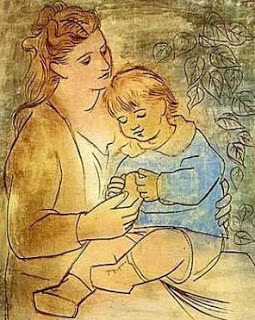
Hello My Friend and Welcome.
We celebrated Mother's Day this past weekend and I'm sure many of us heard a sermon on Mothers. I came across this set of Beatitudes and, in the spirit of our nuturing mothers...and fathers, I thought I'd share it today.
Beatitudes for Parents
Blessed are those who make peace with spilled milk and with mud, for such is the kingdom of childhood.
Blessed are those who do not compare their child with others, for unto each is the rhythm of growth.
Blessed are those who have learned laughter, for it is the music of a child's world.
Blessed are those who understand the goodness of time, for they make it not a sword that kills growth but a shield to protect.
Blessed are those who can say no without anger, for the security of firm decsion comforts a child.
Blessed is the gift of consistency, for it eases a child's heart.
Blessed are the teachable, for knowledge yields understanding, and understanding brings love.
Blessed are those, who in the midst of the unpromising mundane, offer love, for they bestow the greatest of gifts to eath other, to their children, and in an ever-widening circle, to their fellow man.
Until the next time, we wish you Peace and Blessings.
Published on May 18, 2012 01:00
May 15, 2012
MEETING ROME'S NEED FOR OLIVE OIL
 A Supertanker Loaded With Oil Crosses the Ocean
A Supertanker Loaded With Oil Crosses the OceanHello My Friend and Welcome.
In our industrialized world a constant flow of oil is required to meet increasing demand. The appetite of the United States for oil is unprecedented in human history a recent newspaper headline said. Perhaps. The world, it seems, runs on oil. Our lifestyle and economic processes have become so oil dependent that it’s unthinkable to imagine life without it. And when a powerful nation’s demand for oil outstrips its supply, importing additional supplies seems to be the only viable solution. Like all trade goods oil flows from the haves to have-nots and, given the distances involved, most often moves by ship. Many in the United States are rightly concerned by our increasing dependence upon foreign oil. A recent study blamed rising oil imports for our widening trade deficit. The United States is the largest oil importer in the world and much of this oil comes from the Middle East, an politically unstable region.
NOT ABOUT PETROLEUMHowever, this post is not about the United States’ appetite for petroleum. Rather, we’re going back in time nearly two millennia to examine another time when another nation was equally dependent upon foreign oil coming from, among other places, the Middle East. Today we’ll examine the elaborate system of oil importation Rome developed to meet their population’s insatiable demand for…Olive Oil.The Roman World used olive oil for cooking and fueling their lamps, as a cleaning agent in their baths, as an emollient for grooming and conditioning the skin and hair, as well as a healing balm. Researchers have been examining a dump in Rome hidden beneath earth and grass. Nearly a mile in circumference and known as the Monte Testaccio, it been found to contain a 150-foot high mountain of broken amphorae. Though it’s been covered over for centuries, at one time someone clearly knew what was there. Its name is a combination of the Latin testa and the Italian cocci, both of which mean potshard.
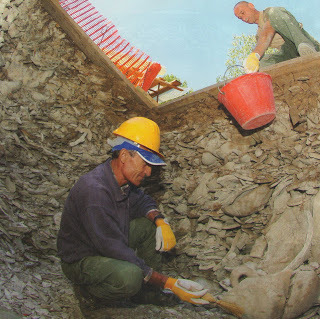 Digging into the Mountain of ShardsDuring the Middle Ages vintners in Rome discovered that the interior of Monte Testaccio remained remarkably cool throughout the year and dug caves into the mountain to store and age their wines. Some imagined it to be the site where debris was dumped following the great fire of Rome during Nero’s rule. Others guessed that the shards were from discarded funerary urns that had once filled columbaria along the nearby Via Ostiense. Regardless, the area provided a seemingly unlimited supply of tiles to patch roofs and souvenirs for tourists.
Digging into the Mountain of ShardsDuring the Middle Ages vintners in Rome discovered that the interior of Monte Testaccio remained remarkably cool throughout the year and dug caves into the mountain to store and age their wines. Some imagined it to be the site where debris was dumped following the great fire of Rome during Nero’s rule. Others guessed that the shards were from discarded funerary urns that had once filled columbaria along the nearby Via Ostiense. Regardless, the area provided a seemingly unlimited supply of tiles to patch roofs and souvenirs for tourists. FINALLY CORRECTLY IDENTIFIED
Only in the last 100 years was it finally recognized for what it was, a dump dating back to the reign of Caesar Augustus. But even then, the amphorae were imagined to have contained wine. Archeologists have only recently unraveled the process behind how this vast mountain of shards was formed. Their digs discovered that a wall of amphorae filled with pieces from other broken amphorae was built to contain the growing mound of shards. When they reached the top of the wall, a new wall was added and the process repeated. The ancient Romans periodically swathed the entire thing in a coating of lime to control the smell of rancid oil.The importation of olive oil, food products, metals and other essentials began early in Augustus’ reign. Keep in mind that Octavian, later to be known as Augustus, began his reign in 31BC. He was only the second ruler of the nascient Roman Empire which his predecessor, Julius Caesar, founded a mere thirteen years earlier.
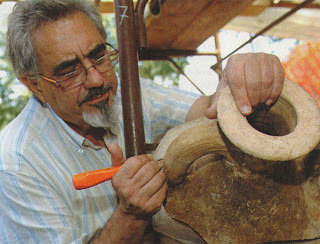 The Intact Neck of a Dressel 20 Amphora
The Intact Neck of a Dressel 20 AmphoraThe majority of the amphorae found at Monte Testaccio came from the Roman province of Hispania(modern Spain and Portugal) and are of a style archaeologically known as a Dressel 20. The remainder came from what we now call the Middle East. A Dressel 20 is a squat, round amphora that resists tipping. They would have been ideally suited to riding in a ship’s cargo hold. Imagine rows of ships docking in the Roman harbor of Portus, each one filled with hundreds, perhaps thousands, of these amphorae. Shipwrecks have been discovered in the region with full loads of Dressel 20’s.
DEALING WITH THE OVERFLOW
From the ships, these large amphorae would have been transported to Imperial warehouses where the oil was transferred into smaller containers for distribution throughout the city. The empties were probably taken to Monte Testaccio by mule and discarded. Like New York City, which temporarily suspended its plastic bottle recycling program due to high cost, Rome undoubtedly found it cheaper to throw away the empties rather than recycle them. Moving the oil in amphora provided a system of inventory control and checks and balances. Their unglazed clay surface is easy to write on. In addition to incised codes put on before firing, many show tituli picti—words, names and numbers used to track their movement through the distribution channels.
MAINTAINING A BALANCE OF POWER
Augustus understood that to remain in power he must have the support of the army and the plebians, the ordinary man in the street. The population of First Century Rome ranged somewhere between 600,000 to a 1,000,000 people. He bought their loyalty with a welfare system that fed the poor, and controlled the price of grain and oil for everyone else. A century later, the Roman poet and satirist, Juvenal, penned his famous line about the Roman emperors buying tranquility with “bread and circuses.”
This system of growing, harvesting, pressing and distribution seems to have operated in a uniquely Roman way. Unlike other empires that became heavily bureaucratic or depended upon great trade routes, Rome utilized a system of small suppliers who were well controlled and monitored. Proof again that individual initiative is always more efficient than centralized planning.
On Thursday we’ll add our monthly link to the Christian Writer’s Blog Chain. This month’s key word is nurture.
Until then, we wish you Peace and Blessings.
If you reached this post via a link, click the HOME tab above to see other recent posts and visit our archives.
Published on May 15, 2012 01:00
May 11, 2012
LECTIO DIVINA — AN ANCIENT FORM OF MEDITATION

Hello My Friend and Welcome.
Today we will be looking at the ancient, four or five-part meditation, used by the Church since earliest times, known as Lectio Divina. The Church Father, Origen (d. 254) and the monk John Cassian (d.435) both wrote of the benefits of this type of meditative study of Scripture. The Twelfth Century monk Guido brought the process into sharper definition as a stairway of spiritual steps. It works well when done alone and is ideally suited for small groups. As a matter of fact, you may be using a similar process and have never heard of it referred to by its Latin name, Lectio Divina. STEP ONE - LECTIOThis is a slow, contemplative method of reading the Scriptures that attempts to enable the Word of God to become a means of union with God. To those who have grown familiar with certain passages and are accustomed to reading them quickly, this can take some work. The first step is reading and active listening to the Word of God. To do this successfully, you must develop the ability to listen carefully to what is read and open your heart to hear God speak to you through his Scripture.

This is very different to the reading most of us do on a day-to-day basis. We’re used to skimming a page of text onscreen or in a newspaper or magazine. Lectio is reading or listening with both mind and heart. It sometimes helps to sit quietly for beforehand, centering your thoughts and stilling your mind. As God has said, “Be still, and know that I am God.” Ps 46:10. When you are ready, read a short passage…only a couple of paragraphs is fine or if you’re reading the Gospels complete one scene.
Listen fully expecting God to speak to you personally through what you are reading or is being read. As you listen, expect one word or phrase to stand out to you. STEP TWO — MEDITATIOAfter you have identified your special phrase or phrases and thought about it, read the passage a second time. Open yourself to the reading and let it speak to your thoughts, dreams, memories and ambitions. Maybe you hearChrist in your verse or perhaps the verse says something about you…where you are in life, etc.
Luke tells us that when the shepherds told Mary of the angels that appeared to them in the field, she “kept all these things, pondering them in her heart.” And later, where Jesus is found after three days in the Temple, Luke again tell us “…his mother kept all these things in her heart.” That is exactly what we want to do; ponder in your heart what these things mean. Now you are asking God to speak to you. STEP THREE — ORATIORead the passage a third and final time. The next step of the Lectio Divinia is speaking to God in prayer, both as dialog and concentration. In the reading we have discovered a truth about ourselves. Now communicate this learning to God, thanking him for it and asking for validation. Now that you have it, what are you to do with it? Always remember, at its heart, prayer is a conversation between two lovers.

STEP FOUR — CONTEMPLATIO
Now we become still and know that God is God. Lay aside your thoughts, worries and concerns and simply experience God’s presence. If it helps to use some sort of centering word or phrase such as Abba-Father, Lord have mercy, Maranatha (Aramaic for Come, Lord) or something else to slow down your mind, by all means, do it. OPTIONAL STEP FIVE — ACTIOSome people suggest a fifth step based on the admonition, “But be doers of the word not hearers only…” Jas 1:22. In this step, being a true disciple, you would attempt to be someone who, “listens to my words, and acts on them.” Luke 6:47. And there you have it. The Lectio Divina is a method of study, contemplation and prayer used by Christians since the earliest of times, and with good reason. Until Next time, we wish you Peace and Blessings. If you reached this post via a link, click the HOME tab above to see other recent posts and visit our archives.
Published on May 11, 2012 01:00



